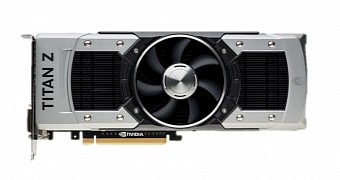Dual-GPU graphics cards are always expensive as sin, due to AMD and NVIDIA not bothering with the concept unless the best GPU technology is implemented, and that takes cash. However, you might get away with paying a lot less for NVIDIA's board under the right circumstances.
You see, the price of the GeForce GTX Titan-Z dual-GPU graphics adapter has been reduced. And not just a little, but by a full 37%.
That's more than a third of the total price off. The board has gone from $2,999 / €2,999 to $1,830 / €1,830. A massive drop in price, to be sure. Unfortunately, there is a catch. There always is.
Basically, you won't find the graphics card sold for so little through retail. Which is to say, the standalone board still has a tag of $2,999 / €2,999.
Instead, the card bears the new price only when shipped to OEMs, which means that pre-configured desktop computers are the only places where you'll find the video board sold for so little cash.
It's a clever trick really. Reduce the price of the video board, one of the three most important components of a high-end computer (alongside the CPU and RAM), and interest in the whole PC will increase while luring OEMs into ordering more cards.
But there is probably another aspect to this. You see, NVIDIA will soon release the Maxwell-based series of graphics adapters, presumably called GeForce GTX 900 now.
It makes sense to want to digest whatever inventory is left of the GK110 Kepler-based graphics processor, to make way for GM204-based and (eventually) GM200-powered adapters, dual-chip or otherwise.
Then again, if a dual-Maxwell board is approaching, it will likely take months for it to be completed, so the GeForce GTX Titan-Z has some life left in it yet.
For those who want a rundown of the specifications, the adapter has 5,760 CUDA cores, a base clock of 705 MHz per GPU, top clock of 876 MHz, and 12 GB of GDDR5 VRAM operating at 7 GHz. The memory interface between the GPU and VRAM is of 768 bits: 384 bits per graphics processor.
This all leads to a texture fill rate of 338 billion per second and a memory bandwidth of 672 GB/s, both of them huge levels. Gargantuan even. Overpowered is definitely the term to describe them.
Then again, the price has been unreasonably high ever since the onset, especially considering that AMD's Radeon R9 295 X2 graphics card only demands $1,500 / €1,500.

 14 DAY TRIAL //
14 DAY TRIAL //